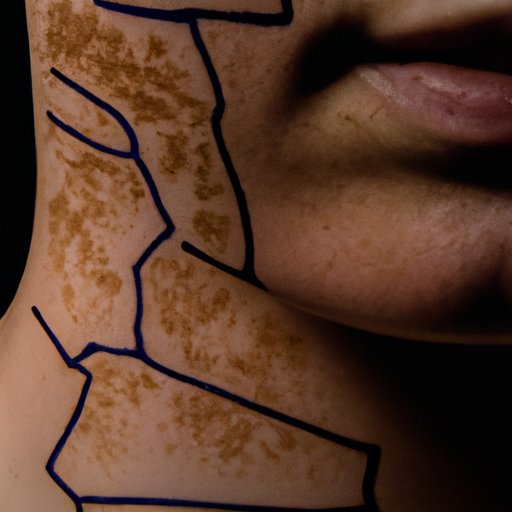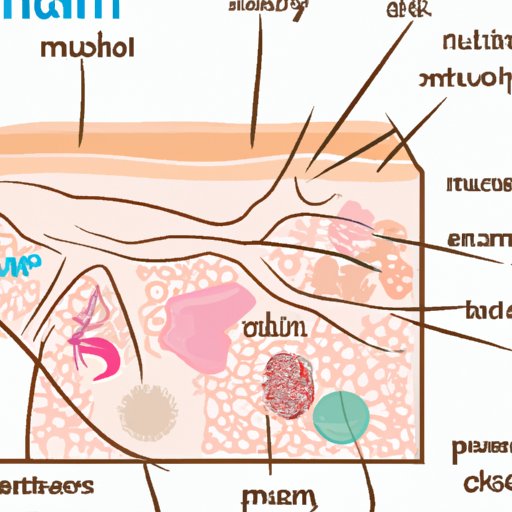Introduction
Skin is the largest organ in the human body, forming a protective barrier between our internal organs and the external environment. While many of us know that skin is composed of cells, there are numerous other components that make up this vital organ. In this article, we’ll explore what skin is made of, examining its chemical makeup, structure, and role in human health.
A Comprehensive Guide to What Skin is Made Of
Skin is composed of three main layers: the epidermis, dermis, and subcutaneous layer. These layers are made up of a variety of cells and chemicals, including lipids, proteins, pigmentation, and mucous membranes. Let’s take a closer look at each of these components.

An Exploration of the Chemical Makeup of Skin
The chemical makeup of skin includes lipids and proteins. Lipids are fatty molecules that form the outermost layer of the skin, providing a waterproof barrier and helping to keep moisture in. Proteins, on the other hand, are responsible for maintaining firmness and elasticity. They also help to bind cells together, allowing the skin to stretch and move as needed.
Pigmentation is another important component of skin. This is the pigment that gives skin its color, and it is produced by melanocytes, which are specialized cells found in the epidermis. Mucous membranes are also present in skin, helping to protect the body from pathogens and keeping the skin moisturized.
Examining the Structure and Function of Skin
The structure and function of skin are intimately linked. The three layers of skin each have their own distinct roles in protecting and regulating the body. The epidermis is the outermost layer, and it serves as a protective barrier against environmental factors like UV radiation, bacteria, and viruses. The dermal layers are located beneath the epidermis and contain nerve endings, sweat glands, and hair follicles. Finally, the subcutaneous layer is composed of fat and connective tissue, and it helps to insulate the body and keep it warm.
In addition to providing protection, the skin also plays an important role in regulating body temperature. Sweat glands release sweat when the body gets too hot, cooling it down. The skin also helps to maintain hydration levels and protect us from UV radiation.

Breaking Down the Anatomy of Skin
The epidermis is the outermost layer of skin and is composed of four distinct layers: the stratum corneum, stratum granulosum, stratum spinosum, and stratum basale. The stratum corneum is the top layer, and it helps to provide a waterproof barrier. The stratum granulosum contains keratin, a protein that helps to protect the skin from damage. The stratum spinosum contains cells called Langerhans, which help to regulate the immune system. Finally, the stratum basale contains stem cells that help to repair any damage to the skin.
The dermal layers are located beneath the epidermis and consist of two main layers: the papillary and reticular layers. The papillary layer contains blood vessels and nerve endings, while the reticular layer is made up of collagen and elastin fibers. These fibers give skin its strength and flexibility.
Finally, the subcutaneous layer lies beneath the dermal layers and is composed of fat and connective tissue. This layer helps to insulate the body and keep it warm.

Evaluating the Role of Skin in Human Health
The skin plays an essential role in human health. It helps to regulate body temperature by releasing sweat when the body gets too hot. It also helps to protect us from UV radiation and other environmental factors, as well as from pathogens. Additionally, the skin helps to maintain hydration levels by trapping water molecules and preventing them from evaporating.
Conclusion
In conclusion, skin is a complex organ composed of various cells and chemicals. Its three layers – the epidermis, dermis, and subcutaneous layer – work together to provide protection from the environment and regulate body temperature. Additionally, skin helps to maintain hydration levels and protect us from pathogens. Understanding the structure and function of skin is essential for maintaining good health.


